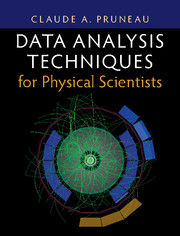Book contents
- Frontmatter
- Dedication
- Contents
- Preface
- How to Read This Book
- 1 The Scientific Method
- Part I Foundation in Probability and Statistics
- Part II Measurement Techniques
- 8 Basic Measurements
- 9 Event Reconstruction
- 10 Correlation Functions
- 11 The Multiple Facets of Correlation Functions
- 12 Data Correction Methods
- Part III Simulation Techniques
- References
- Index
9 - Event Reconstruction
from Part II - Measurement Techniques
Published online by Cambridge University Press: 24 October 2017
- Frontmatter
- Dedication
- Contents
- Preface
- How to Read This Book
- 1 The Scientific Method
- Part I Foundation in Probability and Statistics
- Part II Measurement Techniques
- 8 Basic Measurements
- 9 Event Reconstruction
- 10 Correlation Functions
- 11 The Multiple Facets of Correlation Functions
- 12 Data Correction Methods
- Part III Simulation Techniques
- References
- Index
Summary
Modern nuclear and particle physics detectors are typically very complex and produce large datasets that must be analyzed offlineafter an experiment is completed. The analysis of the experimental data is typically articulated in two main stages known as event reconstruction and physics analysis. Basic elements of physics analyses have already been discussed in Chapter 8 and advanced techniques, mostly pertaining to measurements of fluctuations and correlations, will be presented in Chapters 10 and 11. In this chapter, we focus on key aspects of event reconstruction beginning with a brief overview of basic reconstruction tasks in § 9.1, and followed in § 9.2, with a discussion of track reconstruction techniques, including a detailed example of track reconstruction with a Kalman filter, as well as presentations in § 9.3 of various vertex finding and fitting techniques.
Event Reconstruction Overview
We begin this section with a discussion of the types and structures of data commonly acquired and handled by large experiments in § 9.1.1. We next present a general overview of typical data analysis workflows in § 9.1.2 and conclude with a brief discussion of basic tasks of detector and signal calibration in § 9.1.3.
Types and Structure of Experimental Data
Data produced by large modern experiments typically involve a mix of slow control data characterizing the operating conditions (e.g., power supply settings, magnetic field, currents, time, etc.) and performance of the detector, as well as physics dataproduced by the many sensors and detector components of the experiment, as schematically illustrated in Figure 9.1. Physics data include sensor readout in the form of digitized information produced by analog-to-digital converters (ADCs)and a variety of geographical data indicating the components that produce and report signals. Sensor data may be read out as single values, time sequences, or arrays of various types. They may be sparsified, that is, zero suppressed, or read out in their entirety. Speed is usually of the essence and data are assembled by one or several processors (known as event builders) into data buffers of various complexities and then dispatched for storage and possibly onlineanalysis. Event storage was traditionally accomplished with high-speed magnetic tape drives but is increasingly based on high-performance and high-volume magnetic hard-disk storage systems, as well as optical disks.
- Type
- Chapter
- Information
- Data Analysis Techniques for Physical Scientists , pp. 460 - 501Publisher: Cambridge University PressPrint publication year: 2017



